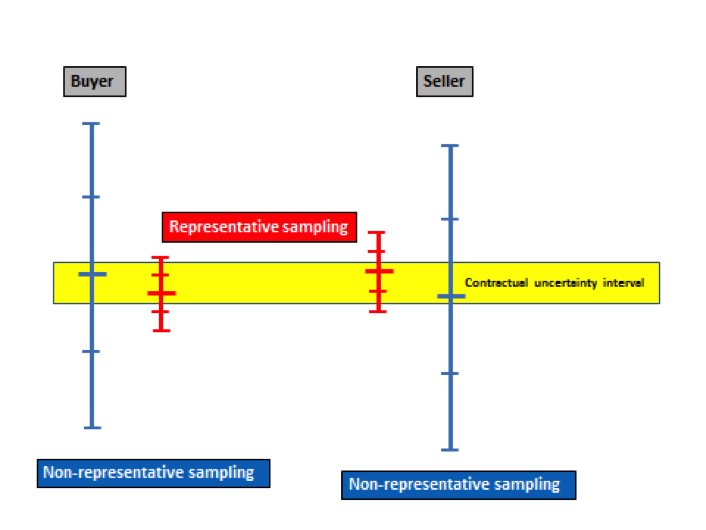A case for TOS (trade, commerce)
TOS reveals a hidden elephant in the room …
According to international trade agreements and codes, disputes between buyer and seller are to be preempted by duplication (or triplication) of primary samples, of which one is analysed by the buyer, the other by the seller.

Extreme heterogeneity (e-scrap) demands representative sampling – by both buyer and seller. This must be codified in contracts.
A third sample is sometimes archived to be used if disputes can only be resolved in a court of law. Sometimes a third party is called for who then either analyses the archival sample, or is asked to perform a completely new primary sampling + analysis. Usually the two analytical results from the buyer and seller are compared, and should ideally fall within a commonly agreed upon uncertainty interval, specified in the contract; the simple average value is then often used for the pertinent business purposes. The interesting case is when analytical differences exceed this acceptance interval in which case the trade codes mandates that the archival sample is forwarded to and analysed by a third, independent party, whose analytical result is sometimes used directly by fiat. If this is not acceptable to one or both parties, the dispute goes to arbitration in a court of law. This will in most cases then dictate to use the average between the two nearest of the three analytical values, upon which to conduct the salient business transaction. This arbitration approach appears logical and easy to follow, and is never questioned likely because there is always a guaranteed resolution.
However there is a hidden elephant in the room – a potentially very big elephant!
There are no stipulations on how the primary samples are to be extracted. Indeed it is commonly accepted that each party or stakeholder is free to use whatever sampling procedure preferred. The focus is only on the magnitude of the final analytical results. It is thus acceptable that the seller and the buyer may wish to perform sampling independently, for example having the seller sample at the port of loading of a ship’s cargo, while the buyer is sampling the same cargo but upon arrival at the receiving port. This is so, because every pair, or every triplicate set of primary samples, is implicitly assumed to be fully representative of the cargo in question, lest the above arbitration rules fall apart completely.
Sampling procedures for which TOS’ demands of elimination of all bias-generating errors (the so-called Incorrect Sampling Errors, ISE) will lead to biased sampling, in principle and in practice without control of the influence of the material heterogeneity. This will unavoidably lead to a significant inflation of the practical sampling variability, the more so the higher the lot heterogeneity. When one, or both parties in an analytical dispute, are not in compliance with the prerequisites for representative sampling, the empirical sampling variability is highly likely to be much larger than the commonly agreed upon contractual uncertainty interval.
This translates directly into a high probability that the analytical results from both parties cannot be resolved but will have to go to arbitration. This is status quo for current international trade agreements, codes and contracts. The degree to which this scheme results in need for arbitration is directly proportional to the inherent heterogeneity of the cargo involved – cargoes with a small heterogeneity will rarely experience need for arbitration, but as cargo heterogeneity goes up so will the number of cases in which comparable analytical results are not observed.
The key feature here is that the degree of heterogeneity of the lot or material is the only determinant w.r.t. the magnitude of the analytical results – not the aptitude of the analytical laboratories involved. Usually analytical errors are very well under control (TAE) – indeed these are practically always neglectably small compared to dominant total sampling errors (TSE). And TSE do not crop up in any contract context!
This means that there will never be a bona fide common basis upon which to evaluate the magnitude and the significance of the difference between any two, or three, analytical results in all resolution effort. As long as there is no agreement/contract/legally bound demand for representative sampling, there will never be an objective basis, nor a rational treatment of analytical disputes. Still this is status quo.
Consequences of non-representative sampling are identical for buyer and/or seller – a fatally inflated sampling variability (blue) making it very rare to be able to satisfy the contractual uncertainty interval (yellow). Things get completely out of control when both buyer and seller, and even a third arbitration party, can all freely choose their own sampling procedure. Resolution of the analytical result comparison issue is only possible when all parties agree only to use representative sampling procedures (red).
For both buyer and/or seller the consequence of non-representative, i.e. biased, sampling is a fatally inflated sampling variability (blue), compared to unbiased procedures (red). Only representative procedures are able to deliver a minimum sampling uncertainty that can be compared to the contractual uncertainty interval (yellow).
Things get really out of control if/when buyer and seller, and/or an arbitration agency, freely can choose their own sampling procedure etc. There is only one way out of this hidden enigma not recognized in current trade agreements and codes – all sampling must be representative, i.e. compliant with the Theory of Sampling (TOS), for example as codified in the international standard DS 3077 (2013).
The mind boggles when it is realised that a single sentence is able to rectify the fatal quagmire outlined above, a sentence to be included in all contracts forthwith when issues of sampling are on the agenda:
“All sampling procedures invoked to secure primary samples, whether by buyer, seller or an arbitration agency, shall be compliant with the principles for representative sampling laid out by the Theory of Sampling (TOS), as codified in the standard DS 3077 (2013); all sampling procedures must be fully documented w.r.t. TOS.”

